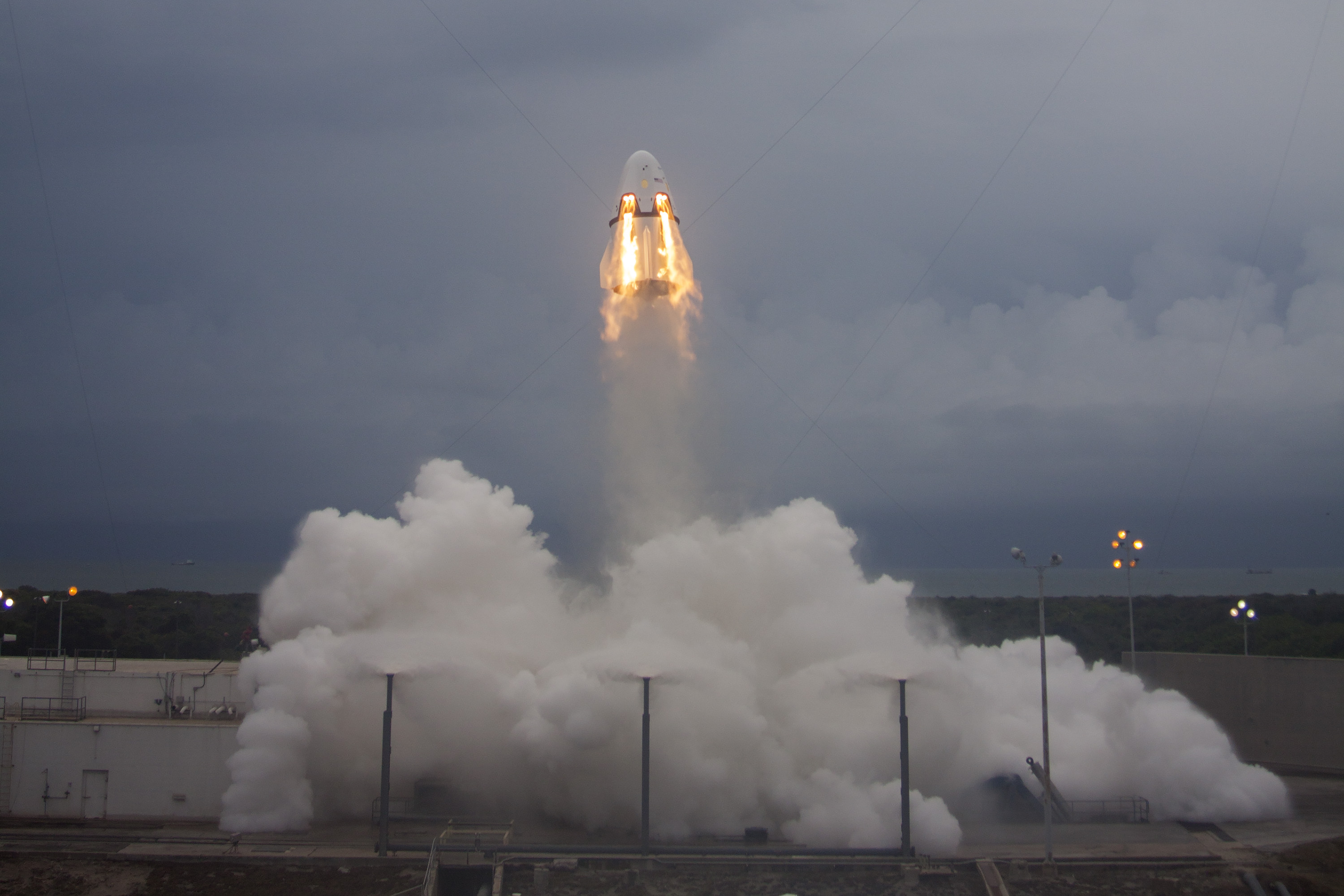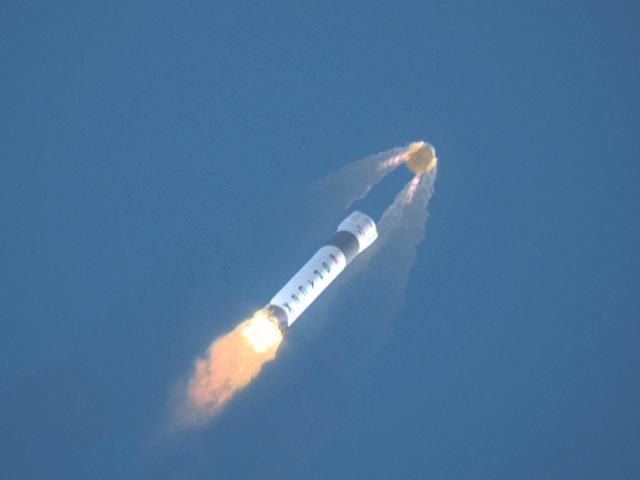The Emergency Launch Abort Systems of SpaceX and Boeing Explained
Not all launch abort systems work the same way.

If anything goes wrong when a crew of astronauts launches into space, their spacecraft always has a built-in abort system to help them return to Earth safely. But not all abort systems work the same way.
In October of 2018, the Soyuz launch-abort system flawlessly brought two International Space Station-bound crewmembers back to Earth after their rocket malfunctioned. In much the same way, the new commercial crew vehicles built by SpaceX and Boeing are designed to safely separate from their rockets and float back down to Earth in case of an emergency.
Neither of these two companies has fully tested the abort system on its new commercial crew vehicle yet. However, both have run into trouble with initial tests of the escape engines that are designed to propel the astronauts to safety. On Saturday (April 20), SpaceX's Crew Dragon suffered a major anomaly during a test fire of the SuperDraco escape engines at Kennedy Space Center in Florida, and smoke could be seen from miles away. Last July, Boeing similarly reported an "anomaly" during a test of the company's launch-abort engines, although there were no reports of dramatic explosions or clouds of smoke.
Watching something designed to save lives go up in smoke may not be very reassuring, especially for the astronauts who plan to fly in those spacecraft. But these "anomalies" will ultimately make the spacecraft safer for astronauts, by helping engineers find and solve any problems before they turn life-threatening.
Related: How Risky Spacecraft Launch Aborts Work (Infographic)
There are two ways that a crewed launch can be aborted: the older, tried-and-tested "pull" method and the newer "push" method. In the older abort mechanism, a small set of rocket boosters is installed on the tip of the crew capsule, giving the rocket's nose a pointy, elongated shape. When the mission is aborted, these downward-facing thrusters "pull" the capsule up to safety after it has separated from the rocket.
NASA first used this type of escape system with Project Mercury, the agency's first crewed space program, as well as the Apollo program that put astronauts on the moon. This is also the kind of escape system on Russia's Soyuz rocket-capsule combo, which NASA has relied on to get astronauts to and from the space station for almost a decade.
Get the Space.com Newsletter
Breaking space news, the latest updates on rocket launches, skywatching events and more!

The idea for a new kind of launch escape system was introduced by Boeing in 2010, but SpaceX was the first to bring that idea to fruition, with the company's Crew Dragon spacecraft. Instead of mounting an escape tower on top of the capsule, SpaceX has built the thrusters into the capsule's outer walls. Eight SuperDraco engines are embedded in the hull and will "push" the capsule away from the rocket in an emergency.
Those SuperDracos were the engines that SpaceX was testing when the explosion happened on April 20. In 2015, SpaceX successfully completed the first test flight of the Crew Dragon's abort system. The company has not yet given a reason for this recent accident, but it could have to do with a change that was implemented since that first test.
Boeing's CST-100 Starliner uses a similar launch escape system as the one on the Crew Dragon, but instead of eight SuperDraco engines, it uses four RS-88 engines, which are built by Aerojet Rocketdyne. The Starliner also had problems with its launch-abort engines during a similar hot-fire test in July 2018, when Boeing reported that engine valves were leaking propellant. There was no dramatic explosion that time, but the first Starliner test flight was subsequently delayed. It is now scheduled to launch in August.
While the two commercial spaceflight companies are rolling with the newer design for a launch escape system, NASA is actually sticking with the old "pull" method with the agency's new Orion crew capsule. NASA will use that spacecraft to launch astronauts to the moon as early as 2024. The agency plans to test Orion's abort system for a second time on June 12. The first test was successfully completed back in 2010. NASA has since made improvements to the system's design using the data the agency gathered during that first test.
All three vehicles would use parachutes to safely bring crews back to Earth, but SpaceX's Crew Dragon could rely on its thrusters as a backup landing capability, Elon Musk tweeted in March. Although SpaceX appeared to be on track to beat Boeing with a first crewed flight to the International Space Station, SpaceX's recent accident likely means that Boeing will get there first. SpaceX has not yet said what caused Saturday's explosion or how it will affect the Crew Dragon's schedule. Its first crewed test flight, Crew Dragon Demo-2, is technically still scheduled for July 25, but that is likely to change.
- Abort! SpaceX, Boeing Taking Different Tacks in Launch Escape Tests
- SpaceX Tests 'Revolutionary' Dragon Launch Escape System to Save Astronauts
- Year to Abort: NASA Preps Orion Capsule for 2019 Ascent Abort-2 Test
Email Hanneke Weitering at hweitering@space.com or follow her @hannekescience. Follow us on Twitter @Spacedotcom and on Facebook.
Join our Space Forums to keep talking space on the latest missions, night sky and more! And if you have a news tip, correction or comment, let us know at: community@space.com.

Hanneke Weitering is a multimedia journalist in the Pacific Northwest reporting on the future of aviation at FutureFlight.aero and Aviation International News and was previously the Editor for Spaceflight and Astronomy news here at Space.com. As an editor with over 10 years of experience in science journalism she has previously written for Scholastic Classroom Magazines, MedPage Today and The Joint Institute for Computational Sciences at Oak Ridge National Laboratory. After studying physics at the University of Tennessee in her hometown of Knoxville, she earned her graduate degree in Science, Health and Environmental Reporting (SHERP) from New York University. Hanneke joined the Space.com team in 2016 as a staff writer and producer, covering topics including spaceflight and astronomy. She currently lives in Seattle, home of the Space Needle, with her cat and two snakes. In her spare time, Hanneke enjoys exploring the Rocky Mountains, basking in nature and looking for dark skies to gaze at the cosmos.









